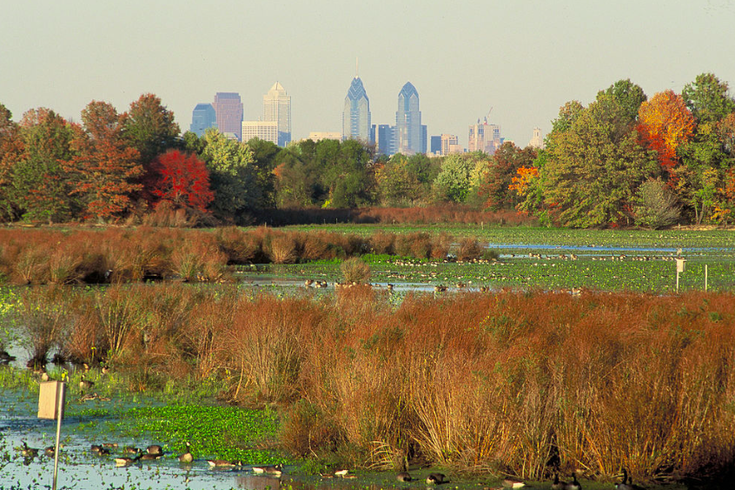
September 20, 2021
 Courtesy/U.S. Fish & Wildlife Service
Courtesy/U.S. Fish & Wildlife Service
John Heinz National Wildlife Refuge will undergo a $1.5 million project during the summer of 2022 to restore natural water flow to 150 acres near Henderson Marsh and create habitats that support migrating waterfowl, migrating shorebirds, fish and various mammals.
For decades, 150 acres of the Henderson Marsh at John Heinz National Wildlife Refuge were used as a dump site for dredge materials.
The area has long been blocked off by giant piles of dirt from the rest of the refuge, serving no purpose for the wildlife who call it home or the thousands of people who visit for recreational purposes, according to Chris Sebastian with Ducks Unlimited, a nonprofit dedicated to wetlands conservation.
"Think of it as a giant natural bathtub," Sebastian said. "It was just there to contain this dredge material."
Over the course of the next year, that will change.
More than $1.5 million will support an effort to reintroduce the marshland into the refuge's natural ecosystem, thanks to grant funding from the National Fish and Wildlife Foundation and the U.S. Fish and Wildlife Service and matching funds from Ducks Unlimited. The area, along with 16 acres of forest, will be completely revamped and feature new kayak launches, fishing piers and interconnected trails, Sebastian said.
"It's gonna be huge for wildlife and also for people to enjoy it," he said.
But first, a lot of dirt — 158,000 cubic yards to be exact — must be moved to restore natural water flow in the area and create habitats that support migrating waterfowl, migrating shorebirds, fish and various mammals. Crews also plan to reintroduce wild rice to the marshland to further restore the area as close to its native conditions as possible.
Construction is scheduled to begin during the summer of 2022, Sebastian said. If all goes according to plan, work could be finished as early as next fall.
"These projects, they can be done in a year," he said. "When they're done, they look like a recently restored construction site … but what I always find really inspiring is how quickly nature takes it back. … Once we put the right habitat conditions in terms of water back there on the ground, nature takes over, and then immediately following are the birds and the wildlife that come back to it.
"It'll be a pretty quick turnaround," he added. "People can actually see it happening right in front of them if they go out there (at) the end of next year and see it and then they come back the next year, it's gonna look completely different."
Established in 1972, John Heinz National Wildlife Refuge spans approximately 1,200 acres of Tinicum Township — not far from the Philadelphia International Airport — and is the largest freshwater tidal marsh in Pennsylvania. In addition to its recreation offerings, the refuge also engages local youth through environmental science explorations and programs that examine the importance of sustainability.
"There's more than 1.7 million people that live within 10 miles of this refuge, and 35 million people live within two hours," Sebastian said. "It's really got a huge connection to lots of people and (is a) great opportunity to have people outside."
The restoration project is just one of dozens throughout the Delaware River watershed being funded by nearly $11.5 million in grants from the National Fish and Wildlife Foundation and the U.S. Fish and Wildlife Service.
Other Philly-area projects include:
•A $460,809 grant and $460,809 in matching funds from the National Audubon Society to "improve urban habitat conditions for year-round and migratory pollinators and birds, improve access to and condition of open spaces for underserved Philadelphia neighborhoods."
•A $250,000 grant and $450,000 in matching funds from the John Bartram Association to create an educational facility to accompany a freshwater mussel hatchery that's in the works at Bartram's Garden through a collaboration with the Partnership for the Delaware Estuary.
•A $175,000 grant and $220,257 from Glenolden, Delaware County to stabilize 550 feet of streambank, build a riparian buffer and redirect flows from a 48-foot stormwater pipe to a wetland in Glenolden Community Park.
•A $151,723 grant and $151,723 in matching funds from Brandywine Conservancy & Museum of Art to remove Hoffman's Mill dam in Chadds Ford, which will improve "aquatic habitat and the restoration of free-flowing waters across the full width of Brandywine Creek."
•A $500,000 grant and $1,149,348 in matching funds from Upstream Alliance to create a 13-mile trail along the Cooper River in Camden, New Jersey, and recreation activities such as fishing and kayaking.